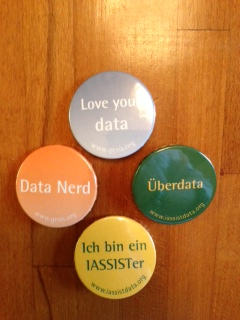Last week I had the pleasure of attending IASSIST 2013 in Cologne, the annual conference of an international membership organisation of data librarians and data archivists, hosted by GESIS, the German social science data archive. Since 1974 this close-knit but dispersed community has been sharing knowledge and experience of provision of academic data services. Data Library staff have served in various elected and appointed posts over the years, and have hosted the conference twice in Edinburgh.
Corresponding with new jobs for data curators, data scientists and data managers, IASSIST has grown from an intimate group of regulars (such as those of us working in the Data Library and the UK Data Archive) to a conference of nearly 300 delegates from 29 countries, with three or four parallel tracks of presentations running across three days plus a training day for workshops.
 Whatever the conference theme–this time it was Data Innovation: Increasing Accessibility, Visibility, and Sustainability— the programme never fails to be an indicator of the latest trends, albeit with a slant towards whichever European or North American country is hosting the conference. One speaker noted that Big Data may have seen its peak, as it was no longer necessary to cram the term into every presentation.
Whatever the conference theme–this time it was Data Innovation: Increasing Accessibility, Visibility, and Sustainability— the programme never fails to be an indicator of the latest trends, albeit with a slant towards whichever European or North American country is hosting the conference. One speaker noted that Big Data may have seen its peak, as it was no longer necessary to cram the term into every presentation.
This year there was a noticeable increase in talks about data enclaves and means of providing access to sensitive personal and corporate data, including a keynote by Tim Mulcahy of NORC on record linkage. Tim set up the first data enclave in the US in 2004. After returning home I learned of a new proposal from the ESRC to fund four administrative data centres in the four UK countries, affirming this important trend towards secure access of sensitive data. As Tim pointed out, it’s much better for researchers than the status quo of not getting access at all.
The most number of talks appeared in the Research Data Management strand (RDM), including my colleague Stuart Macdonald’s presentation of our RDM Roadmap work here at UoE. Attention to RDM has exploded in recent years as research funders have applied more stringent rules to how data is created, managed and shared, to get the most value out of publicly funded research for themselves, researchers and the public. It was gratifying to hear praise by other speakers for MANTRA – our online course for PhD students to learn RDM basics—which has become well-known as an RDM primer.
Another strand covered more long-standing interest in data standards and tools – especially those around the DDI (Data Documentation Initiative) standard used in archiving social science data, which was invented and developed by IASSIST-ers. Data libraries serving a single institution were amply represented by a strand called Data Public Services/Librarianship. As part of a Pecha Kucha set of lightning talks I presented our work in training liaison librarians in RDM and outlined an openly licensed “training kit” that other small groups of librarians anywhere can use to train themselves.
IASSIST has been branching out from the social sciences as institutions such as ours grapple with how to support the data lifecycle across the University and its multitude of disciplines. As I sat on a panel discussing how data libraries and national data archives such as the UKDA can work together, I wondered what the future would bring for a mature set of data-related services that interoperate across an institution (as we’re trying to create through the RDM Roadmap work) and across institutions and the internet. The future for data – and data nerds – seem bright.
Robin Rice
Data Librarian

EDINA and Data Library IASSIST 2013 presentations are available in this EDINA news article: http://edina.ac.uk/cgi-bin/news.cgi?filename=2013-06-10-iassist_2013.txt